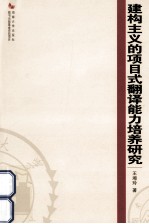
- 作 者:王湘玲编
- 出 版 社:长沙:湖南大学出版社
- 出版年份:2012
- ISBN:9787566701596
- 标注页数:260 页
- PDF页数:286 页
请阅读订购服务说明与试读!
订购服务说明
1、本站所有的书默认都是PDF格式,该格式图书只能阅读和打印,不能再次编辑。
2、除分上下册或者多册的情况下,一般PDF页数一定要大于标注页数才建议下单购买。【本资源286 ≥260页】
图书下载及付费说明
1、所有的电子图书为PDF格式,支持电脑、手机、平板等各类电子设备阅读;可以任意拷贝文件到不同的阅读设备里进行阅读。
2、电子图书在提交订单后一般半小时内处理完成,最晚48小时内处理完成。(非工作日购买会延迟)
3、所有的电子图书都是原书直接扫描方式制作而成。
Chapter 1 Introduction 1
1.1 Defining two terms 2
1.1.1 Translation competence(TC) 2
1.1.2 Market-oriented translation competence 3
1.2 Research significance 5
1.2.1 In discipline building 5
1.2.2 In meeting translation market needs 6
1.2.3 In developing translation pedagogy 10
1.3 Purpose and questions: a framework 13
1.4 The feasibility of the research: a rationale 15
1.5 A brief description of methodology 17
1.6 The general organization of the thesis 20
Chapter 2 A review of previous research 25
2.1 Research on translation competence 26
2.1.1 An evolution of definition 27
2.1.2 Models of translation competence 34
2.2 Research on professional translation competence 40
2.3 Research on developing translation competence 42
2.4 Empirical research 44
2.4.1 Main concerns 45
2.4.2 PACTE 47
2.4.3 Mariana Orozco (2000) 51
2.5 Summary 57
Chapter 3 Constructivism and translation education 61
3.1 Constructivism and its philosophical implications 62
3.1.1 Origin and development 62
3.1.2 Basic concepts 64
3.1.3 Social constructivism 69
3.2 Objectivism versus constructivism in education 73
3.2.1 Objectivism and its philosophical implications 73
3.2.2 Constructivist learning theories 76
3.2.3 Objectivist versus constructivist pedagogy 79
3.3 Constructivist project-based approach in translation education 85
3.3.1 The project-based approach(PBA) 86
3.3.2 The project-based approach and constructivism 87
3.3.3 Building a constructivist PBA model 89
Chapter 4 Evolving a pedagogy model for developing translation competence 93
4.1 The notion of market-oriented translation competence 94
4.1.1 A review of existing studies 94
4.1.2 Components of market-oriented translation competence 100
4.2 A pedagogy for improving market-oriented translation competence 106
4.2.1 Using real-life or real-life-like situations 108
4.2.2 Market-oriented and project-based 113
4.3 Building a workable translation pedagogy model 113
4.3.1 The traditional translation classroom 114
4.3.2 A model of constructivist project-based translation pedagogy 116
4.3.2.1 Preliminary consideration 116
4.3.2.2 The model and its plausibility 119
4.3.2.3 The model as compared with traditional translation teaching(TT) 122
4.4 Measuring market-oriented translation competence 125
Chapter 5 An empirical study on developing translation competence 139
5.1 Research purpose 140
5.2 Research hypotheses 140
5.3 Research design 141
5.3.1 Research subjects 142
5.3.2 The project 144
5.3.2.1 The background 144
5.3.2.2 The job,the organization and the participants 146
5.3.2.3 The process:four periods 148
5.3.3 Research methods 156
5.3.3.1 Literature studies 157
5.3.3.2 Questionnaires 157
5.3.3.3 Follow-up interviews 158
5.3.4 Research instruments 158
5.3.4.1 Questionnaire on translation competence 158
5.3.4.2 Questionnaire on translation quality assessment(TQA) 161
5.3.5 Research procedures 163
5.3.6 Validity control 166
5.3.7 Data collection 168
5.3.8 Data processing 170
Chapter 6 Results and discussions 173
6.1 Statistical analyses of the students' translation competence questionnaires 174
6.1.1 Comparative analyses of the students' translation competence 174
6.1.2 Ranks of translation competence components 178
6.2 Statistical analysesof the students' translation quality(TQ) 183
6.2.1 Statistical analyses of the translation quality assessment questionnaire for the client 183
6.2.2 Comparative analyses of translation quality assessment 186
6.3 Correlation analyses of students' translation competence and translation quality 188
Chapter 7 Conclusion 195
7.1 Findings: revisiting the research questions 196
7.2 Beyond the research questions: pedagogical implications of the study 203
7.3 Limitations of the study and suggestions for further research 206
Bibliography 208
Appendix 222
